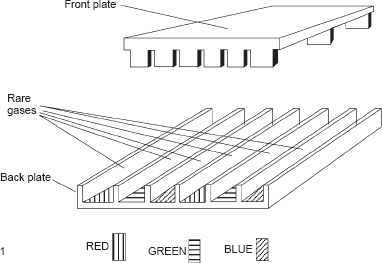Thin video displays are here now.
Plasma Display Screen
There is a limit to how large you can make a CRT. As the CRT gets larger and larger, the glass enclosure must get thicker and thicker to maintain strength; this adds a lot of weight to an already heavy set. A new kind of screen is available for showing video that gives a larger viewing area without the size and weight problems of the very large CRTs. The device is only about 4 to 5 inches thick and is sometimes called a flat-screen display, although the proper name is plasma display screen or device.
The plasma display screen is made up of two pieces of glass sandwiched together. The back part has ridges going vertically down the glass. In the space between the ridges, alternating columns of red, green, and blue phosphors are laid down. For each color of each pixel there is an electrode on the back that is called the data electrode. The front piece of glass has horizontal ridges across it that will seal off each pixel from the others. The front panel also has two transparent electrodes for each pixel color: a scan electrode and a common electrode. When the front and back panels are sandwiched together, rare gases (helium, neon, and xenon) are trapped within the pixel compartments. So if we were to look at an individual pixel of the plasma display screen, there would be a red compartment with a trapped rare gas that has a data electrode on the back and transparent scan and common electrodes on the front. There would be a green and a blue compartment set up the same way. The three compartments together would make one pixel.
How It Works
To activate a color of a pixel, an electrical charge is sent to the scan and data electrodes on the front and back of the screen. This charge electrifies the rare gas inside the pixel segment. A gas with an electrical charge is called a plasma, which is the source of the name for the screen.The plasma gives off an invisible ultraviolet light that causes the phosphor to glow. The phosphor will continue to glow as long as the charge is held and the plasma is active. To turn off the phosphor, the charge is drained off through the common electrode. When the charge is drained, the plasma returns to its uncharged, nonplasma, inactive gas state and the phosphor stops glowing. By activating individual pixel colors and varying the time each color is charged, a full range of colors can be created. Since the color is either on or off and varying voltages are not used, the plasma screen is a digital device.
Besides being only 4 or 5 inches thick, being able to be hung on a wall, and having a very large viewing area, these displays have an excellent contrast range and present very bright pictures. The prices have come down dramatically in the last few years and are now affordable to many people.
1. Plasma display screen.
2. Individual pixel.
3. Pixel element.



